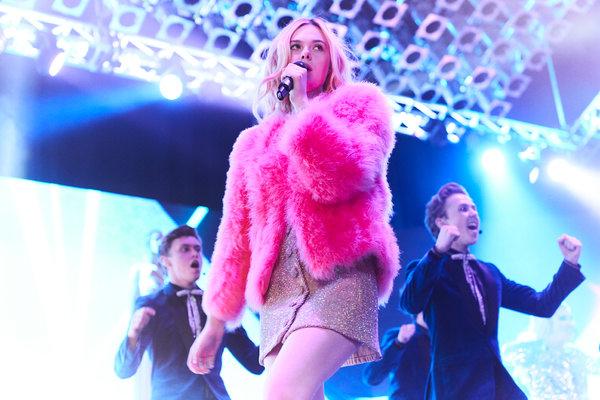by Chris Feil

Cover songs used to be a pop music regularity, whether they were outright hijacked by artists like Elvis or a staple regurgitated among contemporaries. Recent decades have made them pop culture artifacts or ironic reimaginings that overturn the original mood - the era of somber takes on upbeat tunes really fooled us for awhile. And then another cycle came for the cover song: televised singing competitions. This phase comes to life in bisexually lighting in Max Minghella’s Teen Spirit.
The film details Elle Fanning as a young woman named Violet entering a popular singing contest despite the strictures of her Polish mother. She auditions among her peers in her rural UK town for the titular competition, and the lights get flashier as she progresses in this fictionalized reality show. By now these kind of reality shows have become passé, the particulars of which we’ve become quite familiar with as the evolutionary creative chain can be traced all the way back to Star Search.
The rules of the fake one in Teen Spirit are never really fleshed out, but it plays out like a EuroVision-American Idol hybrid. Instead it relies on our understanding of how these kinds of contests work in order to make sense - not unlike a song gone through a meat grinder of cover to cover to cover, until all variations are indistinguishable.
What sets this competition aside (at least to American audiences used to TV shows focused on appealing to as much of a mainstream taste as possible) is that the film’s songbook feels unpretentiously on the pop edge. Violet’s taste skews towards the margins of the pop charts, the kind of artists that have their violently ardent fans despite the fact your coworkers have never heard of them. Similarly Violet is hiding in plain sight at her school, hardly an outcast but also seen as a surprise when she surpasses her classmates at the first open call.
It’s with her first big number that the film achieves its only goal that really matters: revealing Elle Fanning as a superstar in the making. We’ve seen her in plenty of films now, but not quite one that catapults her as this film does. Here she dives into Robyn’s iconic “Dancing on My Own” and the film shifts from her dour reality into full music video euphoria. Fanning’s take on the song is convicted instead of ironic, but still does it justice. Major competitors of programs that the film is mimicking seldom emerge as a comfortable pop star quite as smoothly as the actress does here. The connective thread of this jukebox musical is her convincing vibe.
The rest of Violet’s journey develops as you might expect, with the typical set backs and backstage compromises typical of this kind of narrative. What is more surprising are the songs themselves, opting for the range of Elle Goulding instead of emptier dancible pop, ending with the triumph of Sigrid’s “Don’t Kill My Vibe” whether other films might give her a ballad. All of this feels true to Violet’s hip-synth influences, doing what these singing competitions and cover songs struggle to achieve: Violet feels like a defined artist with a fully formed perspective.
All Soundtracking installments can be found here!